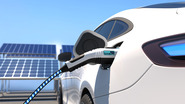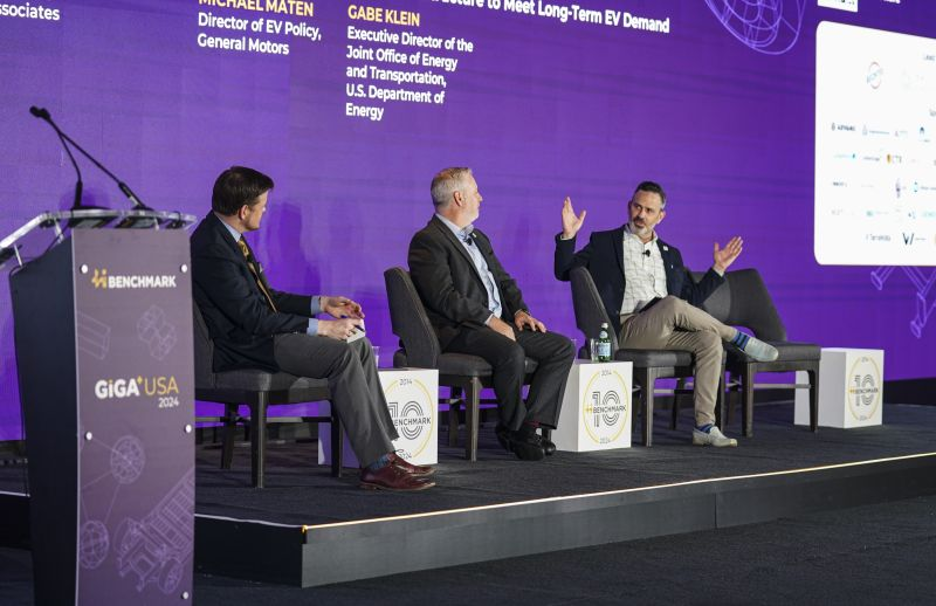|
|
Today is the first official day of summer and the longest day of the year! What a perfect time to take advantage of maximum daylight hours by learning all about new resources, upcoming events, and funding opportunities from the Joint Office of Energy and Transportation (Joint Office).

|
|

EVerest Advances EV Interoperability
The Joint Office announced that the March release of EVerest includes support for the communication protocol requirements defined in the National Electric Vehicle Infrastructure Standards and Requirements and enables plug-and-charge functionality so drivers can simply connect their vehicle to a charger to authenticate, charge, and pay.
World Economic Forum: 3 Ways To Accelerate the Clean Transportation Transition Across Communities
Debs Schrimmer, Joint Office senior advisor for urban and community charging, recently shared three ways to accelerate the transition to electric vehicles (EVs) on a World Economic Forum blog:
- Extend EV charging to more residents.
- Simplify fleet electrification.
- Minimize grid impact.
Read the full piece for details on how the Joint Office is accelerating progress across these goals.
Metropolitan Transportation Authority (MTA) Case Study
A new Joint Office case study demonstrates how transit fleets like New York City’s MTA are committed to retiring fossil-fuel-powered buses for electric buses. Learn how the National Renewable Energy Laboratory (NREL) is helping MTA transition all 5,800 of its buses to zero emissions by 2040.
Other News
EVI-X Modeling Suite for Large-Scale EV Charging Infrastructure Deployments
The EVI-X modeling suite, launched by NREL, informs the planning and development of large-scale EV charging infrastructure deployments—from the regional, state, and national levels to site and facility operations. The EVI-X modeling suite helps understand how a charging station might be designed, what the charging needs are within a region and how that might evolve over time, and the potential cost for developing and designing a charging network from the provider’s and driver’s perspectives. Learn more from the team who built the EVI-X modeling suite.
To Make Better Decisions About Grid Modernization
Planning for grid modernization improvements is increasingly complex and involves many stakeholders with varying degrees of knowledge. To help everyone involved understand power system model results so they can ask the right questions of utilities and improve decision-making, NREL and the Office of Energy Efficiency and Renewable Energy collaborated on a two-part guide covering basic concepts to more advanced technical aspects of grid modeling. Learn more and download the free guides here.
|

Technical Assistance Resources for States and Communities
Grid-Constrained Electric Vehicle Fast Charging Stations: Battery-Buffered Options
This case study can help inform states and other stakeholders interested in battery-buffered options to support DC fast charging stations in grid-constrained locations.
Technical Assistance Help Sheet: Battery Energy Storage for Electric Vehicle Charging Stations
This help sheet provides information on how battery energy storage systems can support EV fast charging. Battery energy storage systems can enable EV fast charging build-out in areas with limited grid capacity, reduce charging and utility costs through peak shaving, and boost energy storage capacity to allow for EV charging in the event of a grid disruption or outage.
Technical Assistance Help Sheet: Physical Safety and Security at Electric Vehicle Charging Sites
This help sheet provides an overview of physical safety and security design elements for public EV charging stations and general best practices that can be considered for the safety and comfort of charging station customers.
Embedding Equity Into Electric Vehicle Charging Station Design
This help sheet from the Joint Office United Support for Transportation (JUST) Lab Consortium provides guidance on planning and designing EV charging stations while incorporating equity into all aspects of the installation, including investment, access, signage, and community engagement.
Embedding Equity Into Community EV Readiness Planning
This help sheet from the JUST Lab Consortium provides guidance for weaving in equity when adding EV infrastructure to your community. It aims to help streamline the approval process for federal funding while ensuring no community member is left behind during this nationwide transition to low-emissions transportation options.
Resource Spotlight
Public EV Charging Infrastructure Playbook
Dig into the first four modules of the Public EV Charging Infrastructure Playbook to discover interactive resources that assist with planning and building infrastructure that supports the transition to zero-emission transportation. Currently, you can access resources on developing EV infrastructure plans, engagement, deployment strategies and site identification, and costs and funding. Stay tuned for the launch of Modules 5–8 for resources on policies and incentives; zoning, codes, and permitting; fees and revenue; and procurement.
Powering Tribal Nations Newsletter
The new Powering Tribal Nations newsletter helps Tribal Nations stay up to date with funding opportunities, events, success stories, and more. Subscribe today.
|
|
|

Charging and Fueling Infrastructure Discretionary Grant Program – Round 2
The Biden-Harris administration opened applications for a historic $1.3 billion funding opportunity for EV charging and alternative fueling infrastructure in urban and rural communities and along designated highways, interstates, and major roadways. This is the largest single grant funding opportunity for EV charging in the nation’s history. Applications are due on Grants.gov by Aug. 28, 2024. Previously unselected applicants will have the option to request via email by July 1, 2024, that the Federal Highway Administration reconsider previously submitted applications.
Coming Soon: Funding for Battery and Electrification Research, Development, Demonstration, and Deployment
The U.S. Department of Energy announced an intent to fund projects that will advance research, development, demonstration, and deployment in several areas critical to achieving net-zero greenhouse gas emissions in the transportation sector. The potential funding will drive innovations in low-cost EV battery manufacturing, using inexpensive and abundant battery materials in support of a viable domestic materials supply chain, and conducting demonstrations of smart charge management. Learn more about this notice of intent and other funding opportunities within the Office of Energy Efficiency and Renewable Energy.
|

Discover the National Zero-Emission Freight Corridor Strategy
June 25, 2024, 4 p.m. ET/1 p.m. PT In March 2024, the Joint Office released the National Zero-Emission Freight Corridor Strategy, setting an actionable vision and comprehensive approach to accelerating the deployment of a world-class, zero-emission freight network in the United States. The strategy aims to help align, unlock, and unleash cross-sector investments in zero-emission medium- and heavy-duty vehicle infrastructure and bolster electric grid and hydrogen planning needed to achieve a zero-emission freight network by 2040. Join this webinar to learn more about the data that informed the strategy, see how hydrogen corridors fit into the national approach, discover industry commitment and key milestones, and how to provide your input on the strategy to shape future phases.
Register for the webinar.
EPA and Joint Office Technical Assistance Webinar Series
The Joint Office is partnering with the U.S. Environmental Protection Agency (EPA) Clean School Bus Program to host a technical assistance webinar series on topics relevant to the clean school bus community.
Topics include:
- July 24 at 1 p.m. ET – Battery Overview, Recycling/End-of-Life Options, and Warranties.
- Aug. 28 at 1 p.m. ET – Building a Case for ESBs in your Fleet including Benefits, Total Cost of Ownership (TCO), and Emissions Calculators.
- Sept. 25 at 1 p.m. ET – Electrification Process including a Step-by-Step Guide for New Adopters.
Register for the EPA webinar series.
|
Upcoming Events
Third Annual EV Charging Infrastructure Midwest Conference
Bridget Gilmore, EV charging fellow, will give an update from the Joint Office at this industry event in Chicago.
Recent Events
- Executive Director Gabe Klein joined Michael Maten, director of EV policy and regulatory affairs at General Motors, for a panel on “Building Resilient Infrastructure to Meet Long-Term EV Demand” at Giga USA on June 11, saying, “It’s absolutely historic. In my lifetime I don't think we've seen investment of this scale in clean energy, renewable energy, clean transportation infrastructure.”
 Gabe Klein participating in a panel at Giga USA on June 11.
- Members of the Joint Office Standards and Reliability team joined other EV charging pros at the CharIN Testival and Conference in Cleveland, Ohio, last week for a live demo of EVerest software and more.
 Pictured (from left to right, beginning with front row): Noel Crisostomo, Jessica Perry, K. Shankari, Sarah Hipel, Pranav Gadamsetty, Jacob Mathews, Tim Coleman, Andrew Meintz, Ed Watt, Sam Thurston, Jason Harper, Dan Dobrzynski, Sally Glass, Mayuresh Savargaonkar, Dhananjay Anand, Bryan Nystrom, John Smart, Ryan Cryar, and Benny Varghese.
|
|
About the Joint Office
The Joint Office is a collaboration between the U.S. Departments of Energy and Transportation to support the buildout of a nationwide network of electric vehicle chargers, zero-emission fueling infrastructure, and zero-emission transit and school buses. Learn more at DriveElectric.gov.
Sign up to receive regular communications about Joint Office vacancy announcements, webinars, news, funding opportunities, and thought leadership pieces on creating a future where everyone can ride and drive electric.
For more updates, follow the Joint LinkedIn.
|
|
|
|
|